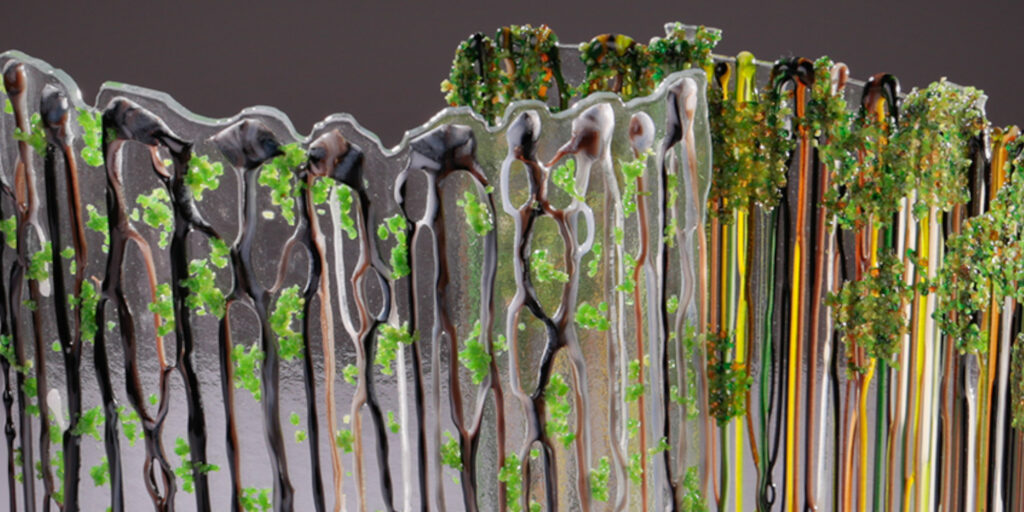
Image: Kristen Flynn | Self-portrait with Grevillea- blue black 2023 | Oil ink on Fabriano paper | 420mm x 297mm
2024 Western Downs Regional Artists Exhibition: Rural Realities Curatorial Essay by Dr Rhiannan Johnson
The theme of this year’s Western Downs Regional Artists Exhibition is Rural Realities. This theme has elicited a visual response from 39 artists, who have collectively submitted 53 works which articulate a diverse range of authentic rural experiences and viewpoints. As an annual regional initiative, this exhibition invites artists who live and create across the Western Downs Region to reflect on their own place in a contemporary arts context and to articulate this through their art. In doing so, they imbue the current landscape of Australian creative practice with authentic rural perspectives staged through contemplation, passion, experimentation and rich storytelling.
The term ‘reality’ itself denotes actuality, or things as they are. On the surface this could be regarded as rigid or absolute, but both individual and collective realities are shaped by the experiences and understandings of those who articulate them. In this respect, the notion of ‘realities’ is complex, layered, interpretable, and fluid. To contextualise this notion through a rural lens, denoting geographical constraints, is to highlight a unique and often underrepresented set of realities through contemporary arts dialogue.
Vast landscapes and sprawling horizons that celebrate the beauty associated with natural settings which have been subjected to limited, if any, interventions were prevalent amongst this year’s submissions. These infer a sense of the sublime and position the viewer to assess their relative physical insignificance in the context of such settings. Interestingly, artists who have engaged with this subject matter, including Alyce Mullen, Patricia Hinz, and Karen Gaskell, have also cited associated dualities. These include peace and foreboding, and plentiful resources and lack. Mullen investigates notions of ‘deceptive peace’, whereby the beauty of the landscape is underpinned by harsh toil and enduring hardship. Hinz explores the notion of an untouched landscape rich with painterly layers and botanical subjects, while simultaneously acknowledging the ever-present threat of urban development. In addressing an oscillating duality, the circular form of Gaskell’s functional ceramic mirrors the reality of cycling through stages of experience – good and bad.
Perhaps the most prominent duality addressed by artists this year was between nourishing rain and drought, while also considering subsequent and associated weather events including bushfires. Artists including Melody Walker, Hilary Coulter, Meg Stevenson, and Machelle Flanigan have contemplated the weather as paramount to their lived realities. Walker speaks to the collective practice of cloud watching and its pervasive presence through interpersonal interactions, daily activities, and future planning and prospects. Through complex and intricate embroidered imagery, Coulter speaks to the ever-present monitoring of the weather as ingrained in the rural experience. The repetitive and almost meditative technical associations of embroidery processes mirror this compulsion. Through dynamic changes in surface quality and colours, Stevenson maps fluctuating landscapes which are manipulated by periods of rain or a lack thereof. Mapping the escalation of extended, severe weather conditions, Flanigan documents the inevitability of fire events alongside the dedicated volunteers who sacrifice their time and safety to respond to and combat emergency conditions.
Demonstrating a natural progression from lived experienced of rural environments and weather conditions, artists including Guy Breay, Brian Hansen, and Valerie Murray have demonstrated a material connection with their everyday reality. This is manifested through the use of found and manipulated materials or resources as art medium. Breay utilises tree remains found on his property and crafts these into technically honed sculptures which command a strong presence in the gallery space. In responding to preexisting shapes and materials, the artist engages in creative dialogue with the site itself to reach a collaborative resolve. Taking an alternate approach, Hansen utilises everyday objects which have been subject to human design and intervention. He transposes these into a gallery setting, shifting their status from everyday function to object significance and mapping the impact of major industries in the region. Through her sculptural practice, Murray engages traditional First Nations weaving techniques informed by her cultural heritage and combines these with found organic matter. This dual approach demonstrates a deep connection with place, imbued with material and symbolic meaning.
Amidst representations of the environment itself, some artists have turned to investigations of the co-existing themes of isolation and connection. While artists including Kay Joyce and Lily Cant reference a lived reality subject to varying levels of geographic and service-based isolation, artists including Sarah Davis, Sheridan Edgar, and Anna Moeba infer notions of connectivity via community and family. Joyce navigates the layered implications of distance in a rural setting, from access to supplies and services, to limits on interpersonal communication and lost opportunities. Cant reinforces the tensions surrounding social connections, and the preoccupation with digital connectivity amidst natural beauty. Conversely, Davis’ bold, layered painting evokes a playful nostalgia, and strong familial ties between sisters sharing a rural upbringing. Through subtle, unassuming visuals created by cast flora, Edgar maps moments of discovery spent with her children in their garden. Moeba photographically documents instances of community connections, in this instance, via gatherings at an art gallery.
At the heart of the reality of rural experience is its people, and artists including Kristen Flynn, Tiarna Lowe, and Katie Robertson have provided unique insight into their individual, and by extension, collective identities. Flynn utilises contemporary printmaking approaches to locate beauty in brevity, weaving her distorted self-portrait through the threads of rural encounters. Lowe connects with her broader culture and heritage, and utilising symbolic meaning to convey her story as a contemporary First Nations artist. As a mother and an artist, Robertson engages with layered narratives surrounding her daughter’s identity, her own, and the rural context which envelopes them.
Collectively, this exhibition offers meaningful insights into what it means to exist and create in a contemporary, rural setting. Through their individual responses to the theme of Rural Realities, the artists involved in this exhibition have demonstrated a deep connection to place and lived experiences, realised through narratives of diversity, resilience, enduring spirit, identity, and place. While there are several overarching themes woven throughout this exhibition, perhaps the only consistent finding is that the notion of rural realities is anything but singular. These realities are at times paradoxical, imbued with layered meaning, and highly nuanced.
